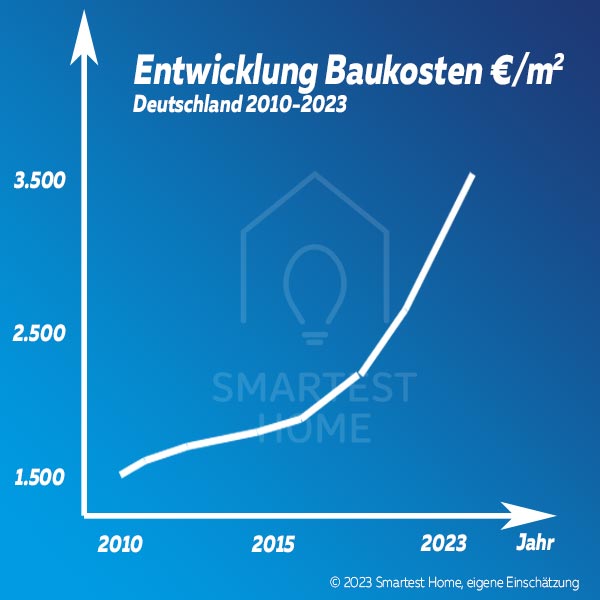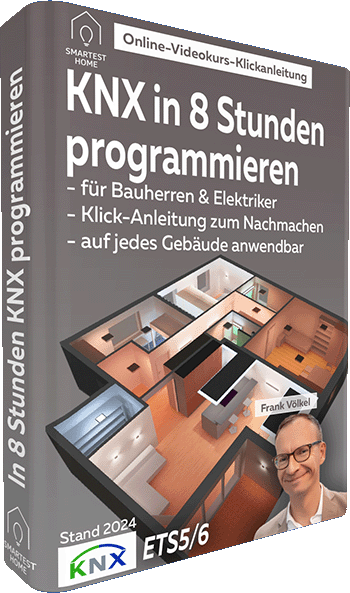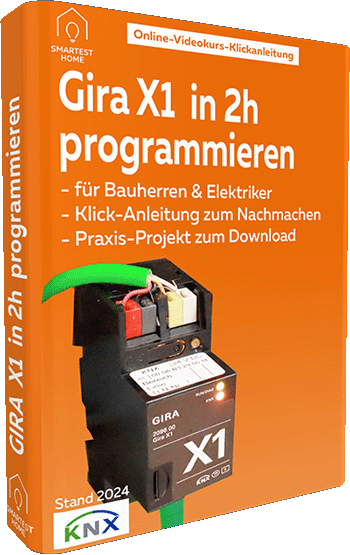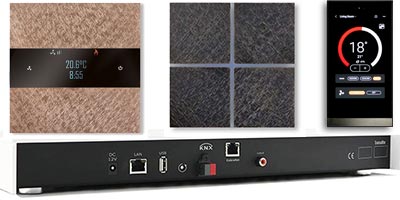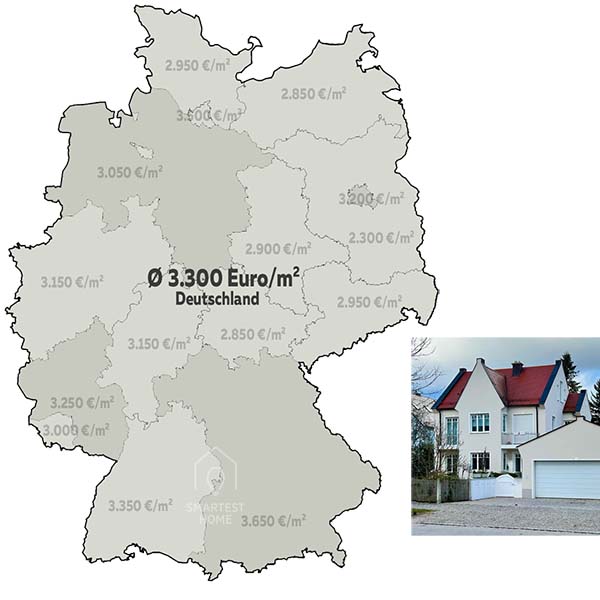
How can I save costs and still build high quality? How do I cleverly reduce the construction costs per square meter for a residential building in 2023? These are very crucial questions when building a house and only very few builders who have a real perspective and a lot of experience in dealing with the individual trades and their costs are able to do it.
We use examples to show how high the construction costs for a single-family house or apartment building are and where there is immense potential for savings. This is particularly true today, when after years of sharp price increases (2018-2022) in general in the house construction industry, prices are slowly falling again.
If you want to build your house cost-efficiently, you have to plan consciously and optimally right from the start. He has to know the costs for all the details (really all of them!) and not let the construction budget get out of hand with overpriced offers from various tradesmen. Because additional costs of 25% to 30% are quickly reached, which in some private builders blow up the already tight budget and make house construction impossible. How do we know? From many years of experience with builders who have realized their personal dream of an individual family home.
Table of contents: Construction costs per square meter
What will it cost to build a house in 2023? Policy Questions
- How do we create as much space as possible for as few shell construction costs as possible?
- How big should the building be in square meters?
- How many storeys (full storeys) should it have?
- Is a basement absolutely necessary?
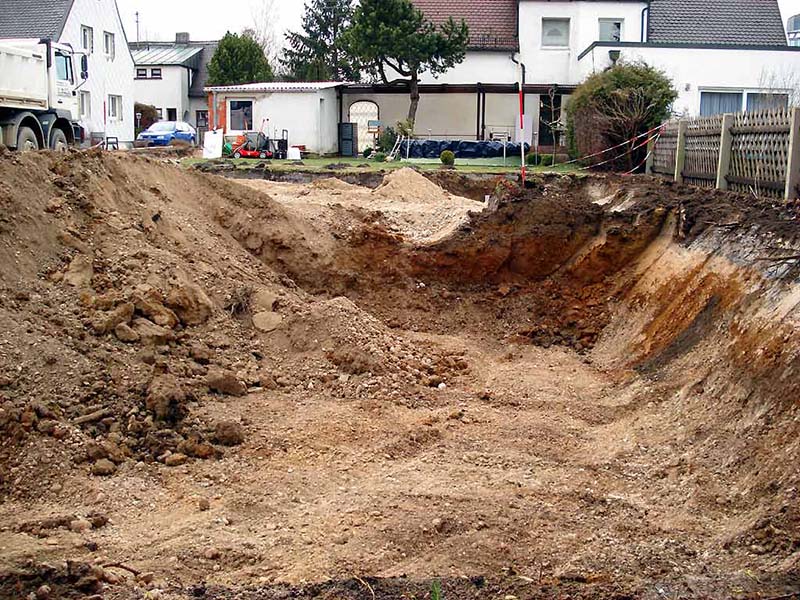
Basement vs. floor slab: Huge cost savings?
The most expensive floor of a house is the basement! So what could be more obvious than to omit the basement right away and at the same time save on the expensive excavation, which can be very time-consuming depending on the location (slope, level ground, area with high groundwater, etc.). Depending on the size of the building, that’s 90,000 to 150,000 euros.
But it’s not that easy! A house with a basement quickly has 30% more floor space than a house without a basement. The additional costs for a standard house with 150 to 200 square meters of living space amount to only 15% to 18% of the construction costs. At least that is our experience with many builders who have set up their KNX Smart Home.
Especially in areas where the property price (price per square meter of building land) is above 1,000 euros/sqm or even higher, building a basement always makes sense. Why is that? Because then there is usually no more land available to build the lost basement area in the “broad”. Finally, a replacement area must be created for the basement that has not been built, which can contain, for example, a technical room, laundry room, utility room and fitness room.
In the greater Munich area in Upper Bavaria, for example, i.e. the city of Munich itself, in the district of Munich and e.g. in the districts of Starnberg, Fürstenfeldbruck, Ebersberg and Miesbach – where we often travel, building a basement always makes sense. Because in the Munich area, the prices for building land are often above 1,000 euros per square meter.
Overview: What will it cost to build a house in 2023
Almost every builder asks himself the question before building a house: How much does it cost to build a house? The table above gives a basic overview of the individual construction phases and their construction costs per square meter in 2023. We must always bear in mind that house construction costs per square meter (construction costs) have risen by around 80 percent over the past 10 years. At the same time, the construction quality and the quality requirements of most builders are significantly higher than 10 years ago! So the claims could also have increased by that percentage.
As far as construction costs are concerned, a lot of information from banks and insurance companies is completely outdated and comes from surveys from 3 to 5 years ago that are based on statistical data.
The background: The sharply increased prices of the past few years are not yet included.
Added to this is the very high demand for construction services and the still limited availability of skilled workers in Germany.
We will come to the details of what is included in the individual construction costs later.
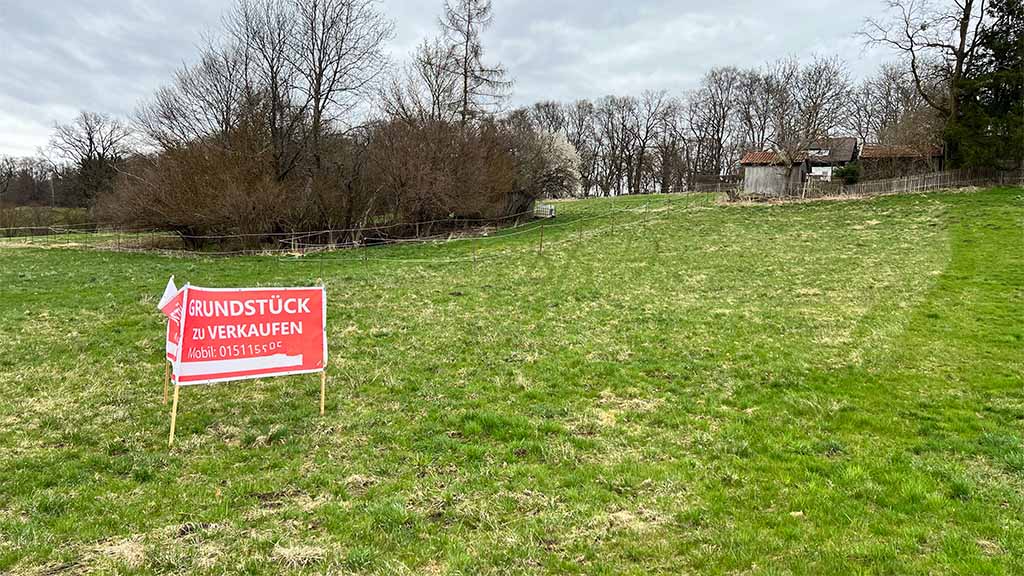
The four basic construction phases
The various trades are subordinate to the individual construction phases of every house construction. Trades are sub-areas when building a house, which can vary somewhat depending on the degree of equipment, the desired level of comfort and the future viability (our know-how KNX Smart Home!). In principle, every individual house construction should proceed as shown in the table.
In our examples, we deliberately kept the construction phase “furnishing” or equipment a little “smaller” in order to stay within the budget of 3,000 euros construction costs per square meter (see table above).
Prices for building ground and property: 50 euros to 5000 euros per square meter
Basically, the construction costs have nothing to do with the price of building land or the property per square meter. However, when deciding whether to start building a house with or without a basement, the price per square meter for the property is crucial.
Because it makes a big difference whether the house is to be built far away from a strong economic region or in one of the expensive districts in Upper Bavaria or even in Munich itself.
Overview: basement types and without basement
There are basically three different ways to build a house: Without a basement, only with a base plate (floor slab), with a basement outside of the groundwater and inside the groundwater. If the basement is to be completely watertight, it must be built with waterproof concrete (waterproof concrete with a steel structure). In colloquial language WU concrete is also referred to as “white tub”.
A watertight basement is never included in the basic cost of a home or base calculation and is comparatively more expensive than a “normal” basement.
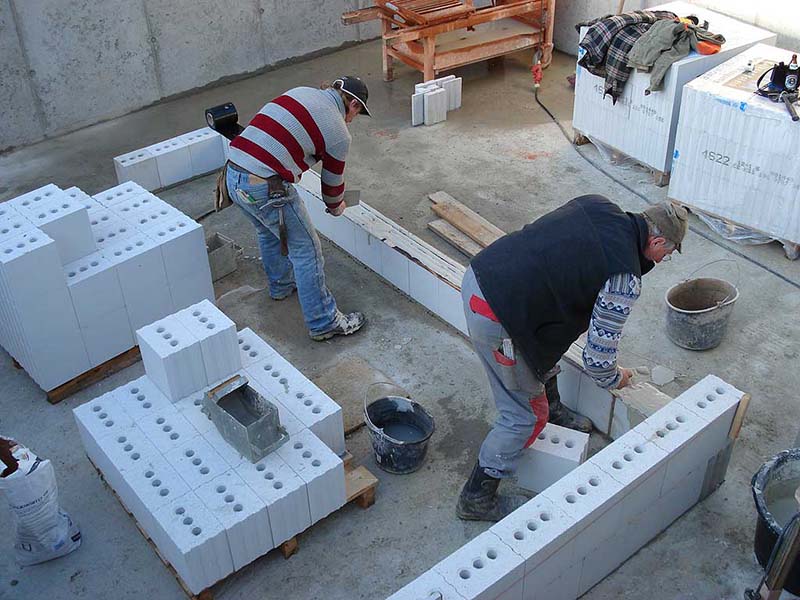
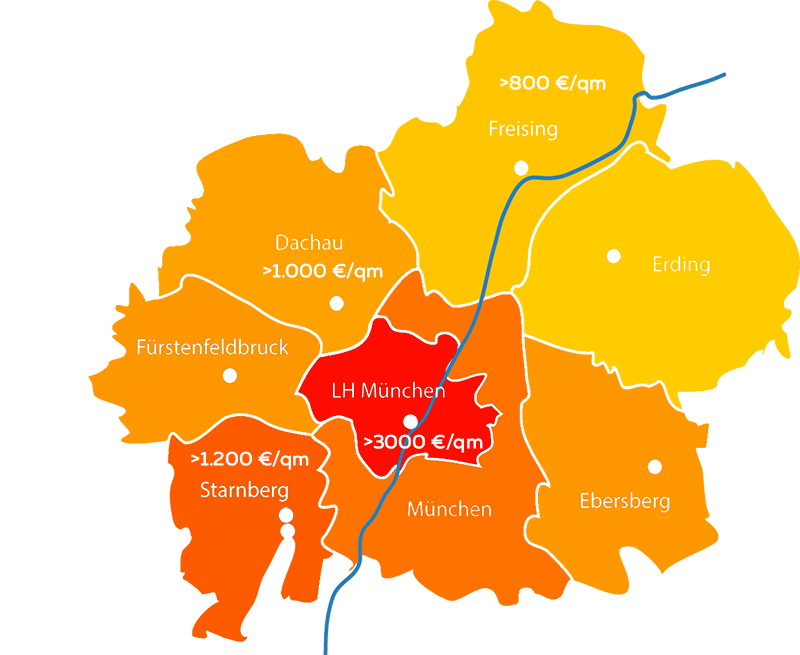
Shell construction: cost savings without sacrificing construction quality
This is also very important: use the living space as optimally as possible. This means that the simpler and more compact the shape of the house, the cheaper it will be. A building without ledges is cheaper than a house with many ledges and bay windows. The same applies to dormer windows and additional entrance areas: These are definitely additional costs compared to a simple house shape.
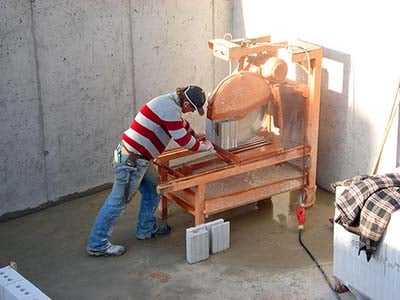
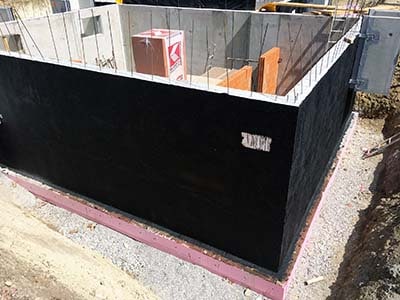
- Minimize exterior walls (avoid house shape, bay windows and dormers)
- Minimize interior walls (room layout, architecture)
- Minimize interior doors, applies to bathroom, kitchen, living room
- open floor plans: merged rooms, multiple use, avoidance of corridors help to save construction costs. Interior walls and interior doors can also be saved.
- Number of floors: Bungalow or multi-storey is also a question of money: a staircase requires additional space, if it is built at ground level, this can be saved. At the same time, there are no false ceilings.
- Stairs: External stairs are cheaper if no stairwell is built around them and therefore no living space is taken up
- Sanitary facilities: clever arrangement saves costs. If bathrooms and kitchens are on top of each other or next to each other, cable lengths can be optimized.
- Technology shaft: If you pack all the cables for all trades in a space-saving technology shaft to optimize costs, you save a lot of money
- Roof shape: Pent or gabled roofs are the simplest and cheapest roof shapes. If the span is not too large, the roof construction is also cheaper.
- Expansion: savings without loss of quality, with almost all components you have to decide between cheap and expensive solutions.
- Windows: take the cheap double glazing windows or expensive triple windows?
- Flooring: cheap linoleum or high-quality oak?
- Building fabric: In no case should the quality of the house be impaired and certainly not the “building fabric”. Always think about resale!
- A high-quality construction scores with a better indoor climate and the value of the building is retained for 75 to 100 years.
Expansion: savings without sacrificing construction quality
This raises the question: How is it actually possible to keep the costs within an absolutely low range despite the high construction quality? The solution is to opt for the inexpensive option for the points listed below. Especially with things that can later be exchanged as desired in further expansion steps.
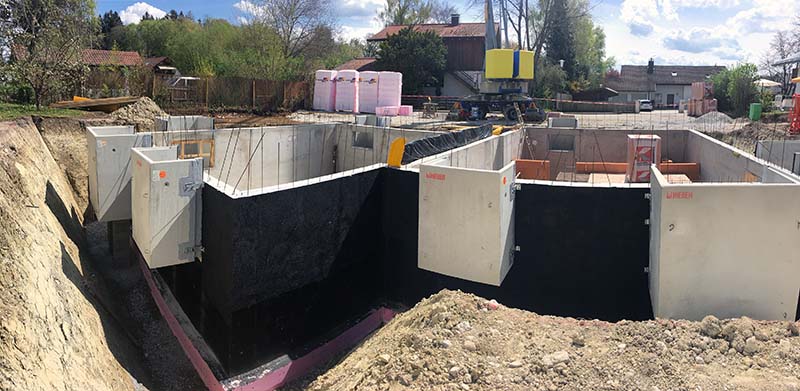
- Floor coverings can vary greatly in price. Inexpensive alternatives to the classic coverings are, for example, industrial parquet, industrial screed, screed with paint or linoleum flooring. But solid oak floorboards can also be cheap. It’s worth comparing. And the quality doesn’t have to be worse than expensive wooden or designer floors.
- Tiles: Tiled areas in the bathroom and toilet can be reduced to the essentials. A cheap solution is not to tile the walls in less critical areas, but to paint them waterproof.
- A lot can also be saved when furnishing the kitchen and bathroom. The structure of the building is not affected and later retrofitting is always possible.
- Windows: better a few large windows than many small and different windows. However, you should not save on the quality of the double or triple glazing and the window frames.
- Ceiling and wall surfaces can also be left open and unplastered. That saves a lot of money. Exposed concrete ceilings or visible wooden beam ceilings also make a visual difference.
- Plasterboard interior walls can be cheaper than solid interior walls. If the impact sound insulation of the individual rooms is not that important, then the plasterboard walls can also be placed on the finished floor and the room layout remains flexible.
Savings through personal contribution and gradual expansion
Depending on your willingness and ability to organize the planning and construction of the house yourself and how much time you want to invest in it, you can save a lot of money by doing your own work and gradual expansion. This in turn pushes the construction costs per square meter below the 3000 euro mark.
Price comparison: solid house, prefabricated house and architect house
The table below compares the basic construction costs per square meter when building a house. It is pretty obvious that prefab house construction has no price advantage compared to building a solid house – quite the opposite: Due to the high demand in recent years and the so-called “turnkey construction”, the construction costs are higher than for other types of house construction.
So if you don’t want to take care of “anything” yourself, you pay a significantly higher price (!) for the construction of your house “from a single source”. The construction company or the provider only assigns a whole range of the trades as an order to external companies, since they cannot do everything themselves.
When it comes to assessing the costs of a single-family house, the construction costs per square meter are always decisive. This is the essential parameter that every builder should use for assessment.
A sample calculation: An average single-family home should have 150 square meters of living space with a basement of 80 square meters. This is how we can calculate on average: 230 sqm x 3000 euros/sqm = 690,000 euros.
In the calculation above, an average house with medium equipment is completely finished with the construction standard of the year 2023. More on that in the next part of this post.
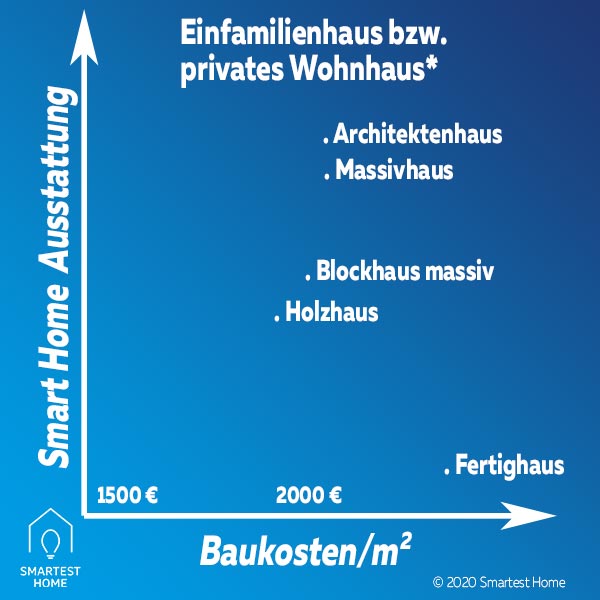
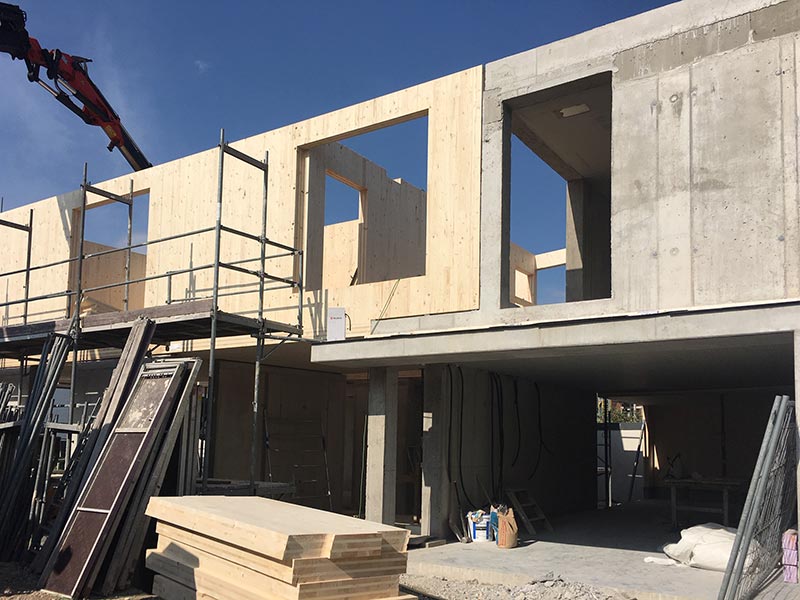
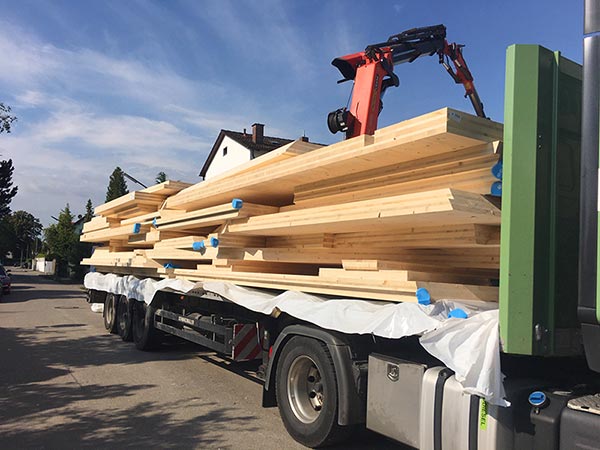
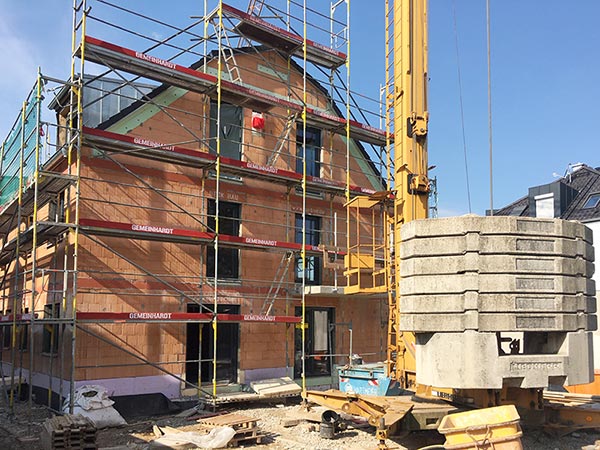
Why small house more expensive than big house?
We see it again and again and for many it is certainly not new: a small house costs more per square meter than a large house. So it’s again about the construction costs per square meter. Why is that? On the one hand, the infrastructure and technology per square meter (this applies to the entire building services, heating, ventilation, shading, lighting, etc.) will be somewhat cheaper if it is rolled out over a larger area or volume. On the other hand, the costs for the sub-trades are also somewhat cheaper. At least that’s our experience.
Exact figures will follow shortly after we have set up the sample calculation.
Why construction costs in Germany are almost the same everywhere
Even if it doesn’t seem logical to most people at first glance as far as the construction costs in Germany are concerned. The building material (bricks, concrete, sand-lime brick, etc.), the fittings (windows, doors, interior fittings, etc.) and the labor cost the same everywhere in Germany. This is our experience from many projects and regions, where we have compared and analyzed the prices.
While in the south of Germany (where we are at home) the prices for building materials are a bit cheaper than in the north and east of Germany, the labor costs are a bit higher.
Conclusion: Overall, building a house or building a single-family house with the same equipment costs about the same in all regions of Germany. That brings with it competition among construction companies.
A comparison of the average construction costs per square meter with our neighboring countries shows that building a house is more expensive in Austria and much more expensive in Switzerland than in Germany. Even in Italy, as a builder, you pay more for the construction of a single-family house – again and again with regard to the “construction costs per square meter”.
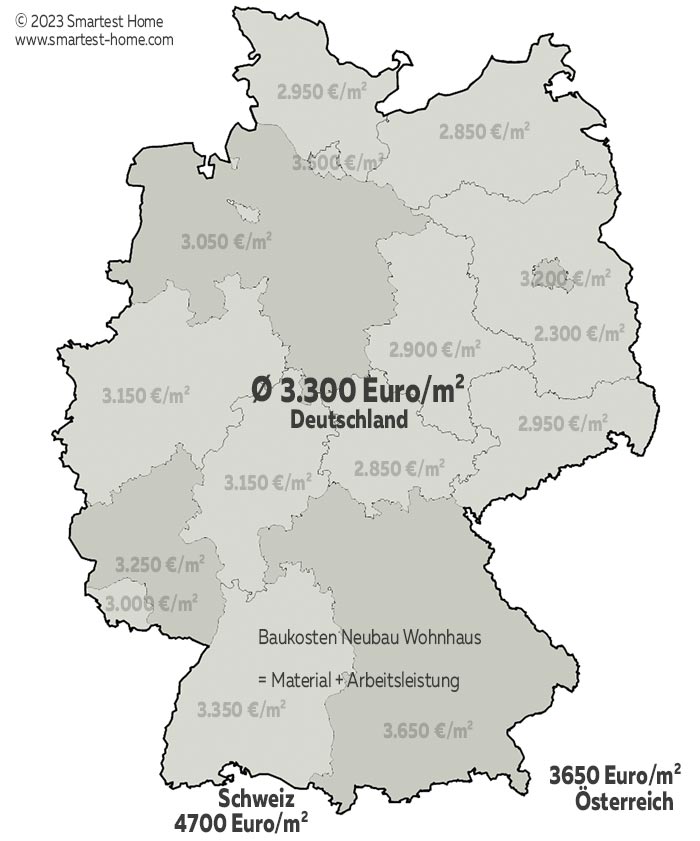
Trend of construction costs per square meter from 2010 to 2023
Looking back over the past 13 years, one thing is clear: the construction costs per square meter have risen significantly in Germany. Compared to the average construction costs, which were around 1450 euros for one square meter of living space in 2010, the construction costs today are at least 3300 to 3500 euros per square meter of living space. That’s an increase of 141 percent!
